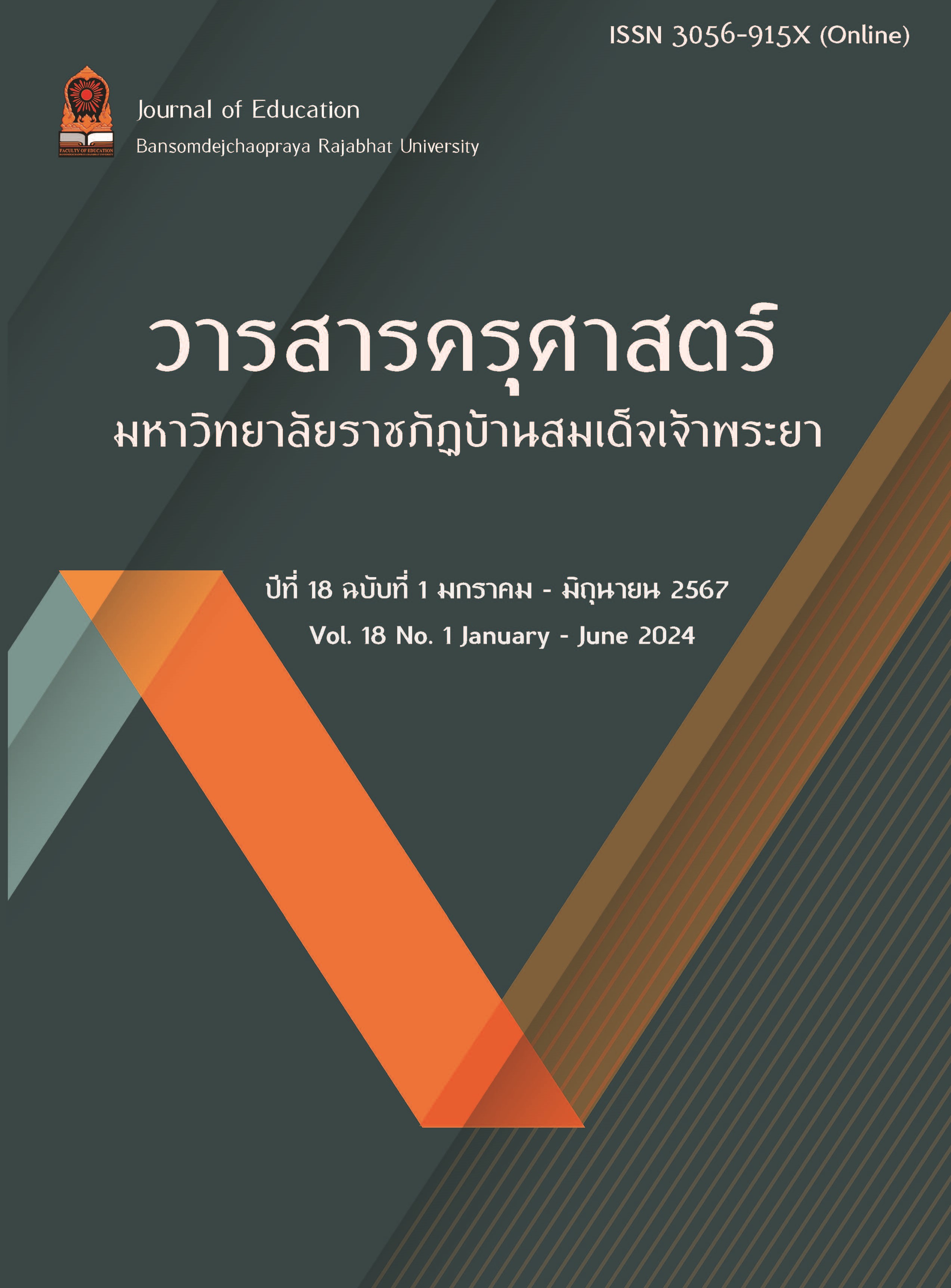การพัฒนาผลสัมฤทธิ์ทางการเรียนวิชาคณิตศาสตร์ เรื่อง โจทย์ปัญหาการบวกและ การลบของนักเรียนชั้นประถมศึกษาปีที่ 4 โดยใช้วิธีการจัดการเรียนรู้แบบ KWDL ร่วมกับเทคนิคบาร์โมเดล
คำสำคัญ:
ผลสัมฤทธิ์ทางการเรียน, การจัดการเรียนรู้แบบ KWDL, เทคนิคบาร์โมเดลบทคัดย่อ
การวิจัยมีวัตถุประสงค์เพื่อ 1) พัฒนาผลสัมฤทธิ์ทางการเรียนวิชาคณิตศาสตร์ เรื่อง โจทย์ปัญหาการบวกและการลบ ของนักเรียนชั้นประถมศึกษาปีที่ 4 โดยใช้วิธีการจัดการเรียนรู้แบบ KWDL ร่วมกับเทคนิคบาร์โมเดลเทียบกับเกณฑ์ร้อยละ 70 2) เปรียบเทียบผลสัมฤทธิ์ทางการเรียนวิชาคณิตศาสตร์ก่อนและหลังเรียนโดยใช้วิธีการจัดการเรียนรู้แบบ KWDL ร่วมกับเทคนิคบาร์โมเดล และ 3) ศึกษาความพึงพอใจของนักเรียนหลังการจัดการเรียนรู้ กลุ่มเป้าหมายในการวิจัย ได้แก่ นักเรียนชั้นประถมศึกษาปีที่ 4 กำลังศึกษาในภาคเรียนที่ 1 ปีการศึกษา 2566 โรงเรียนชุมชนยอดแก่งสงเคราะห์ จำนวน 1 ห้องเรียน นักเรียนจำนวน 25 คน ซึ่งได้มาจากการเลือกแบบเจาะจง เครื่องมือที่ใช้ในการวิจัยคือ แผนการจัดการเรียนรู้จำนวน 6 แผน แบบทดสอบวัดผลสัมฤทธิ์จำนวน 1 ฉบับ มีค่าความยากง่ายระหว่าง 0.36 - 0.71 ค่าอำนาจจำแนกระหว่าง 0.29 - 0.86 ค่าความเชื่อมั่นเท่ากับ 0.83 และแบบวัดความพึงพอใจจำนวน 1 ฉบับ จำนวน 10 ข้อ มีค่าดัชนีความสอดคล้องเท่ากับ 1.00 สถิติที่ใช้ในการวิเคราะห์ข้อมูล ได้แก่ ค่าเฉลี่ย ค่าเบี่ยงเบนมาตรฐาน ค่าร้อยละ และสถิติทดสอบที
ผลการวิจัยพบว่า
1) นักเรียนมีผลสัมฤทธิ์ทางการเรียนคณิตศาสตร์ เรื่อง โจทย์ปัญหาการบวกและการลบ ของนักเรียนชั้นประถมศึกษาปีที่ 4 หลังได้รับการจัดการเรียนรู้ มีค่าเฉลี่ย 14.72 สูงกว่าเกณฑ์ร้อยละ 70 อย่างมีนัยสำคัญทางสถิติที่ระดับ .05
2) นักเรียนมีผลสัมฤทธิ์ทางการเรียนคณิตศาสตร์หลังเรียนโดยใช้วิธีการจัดการเรียนรู้แบบ KWDL ร่วมกับเทคนิคบาร์โมเดลสูงกว่าก่อนเรียนอย่างมีนัยสำคัญทางสถิติที่ระดับ .05
3) ความพึงพอใจของนักเรียนต่อการจัดการเรียนรู้อยู่ในระดับมากที่สุด มีค่าเฉลี่ยเท่ากับ 4.69 ส่วนเบี่ยงเบนมาตรฐานเท่ากับ 0.42
Downloads
เอกสารอ้างอิง
กรองทอง ไคริรี และ ฉวีวรรณ แก้วไทรฮะ. (2554). คู่มือครูการแก้โจทย์ปัญหาคณิตศาสตร์โดยใช้ รูปบาร์โมเดล (Bar Model) ชั้น ป.4. กรุงเทพฯ : เอ ทีม บิสซิเนส.
ฉัตรกาญจน์ ธานีพูน.(2562).การพัฒนาความสามารถในการแก้โจทย์ปัญหาเลขคณิต ของนักเรียนชั้นประถมศึกษาปีที่ 3 โดยใช้กระบวนการแก้ปัญหาของโพลยา ร่วมกับบาร์โมเดล.วิทยานิพนธ์ปริญญาวิทยาศาสตรมหาบัณฑิต, สาขาวิชาคณิตศาสตร์ศึกษา, คณะวิทยาศาสตร์, มหาวิทยาลัยมหาสารคาม.
ฉัตรกาญจน์ ธานีพูน และ นงลักษณ์ วิริยะพงษ์. (2563). การพัฒนาความสามารถในการ แก้โจทย์ปัญหาเลขคณิตของนักเรียนชั้นประถมศึกษาปีที่ 3 โดยใช้กระบวนการแก้ปัญหาของโพลยาร่วมกับบาร์โมเดล. วารสารมนุษยศาสตร์และสังคมศาสตร์มหาวิทยาลัยสุรินทร์,22(1),93-105.
ปาริสา ไชยกุล. (2563). ผลการจัดการเรียนรู้ เรื่อง การบวก ลบ คูณ หารระคนโดยใช้สมองเป็นฐาน ร่วมกับเทคนิค KWDL ที่มีต่อความสามารถในการแก้ปัญหาทางคณิตศาสตร์และความสามารถ ในการคิดวิเคราะห์ของนักเรียนชั้นประถมศึกษาปีที่3. วารสารวิชาการมหาวิทยาลัยราชภัฏศรีสะเกษ, 14 (3), 61-71. สืบค้นจาก https://so05.tcithaijo.org/index.php/sskrujournal/article/view/248676/168860.
ปรียา สิถิระบุตร. (2557). การพัฒนาทักษะการแก้โจทย์ปัญหา เรื่อง การคูณ การหาร สําหรับ นักเรียนชั้นประถมศึกษาปีที่ 4 ด้วยการจัดการเรียนรู้โดยใช้เทคนิค KWDL ร่วมกับการวาดรูปบาร์. วิทยานิพนธ์ ครุศาสตรมหาบัณฑติ . อุบลราชธานี :
ไพศาล วรคํา. (2561). การวิจัยทางการศึกษา. (พิมพ์ครั้งที่ 9). มหาสารคาม: ตักสิลาการพิมพ์. มหาวิทยาลัยราชภัฎอุบลราชธานี.
วัชรา เล่าเรียนดี. (2549). เทคนิคและยุทธวิธีพัฒนาทักษะการคิดการจัดการเรียนรู้ที่เน้นผู้เรียนเป็น สําคัญ. นครปฐม : โรงพิมพ์มหาวิทยาลัยศิลปากร.
ศศิธร แก้วมี. (2554). การพัฒนารูปแบบการจัดการเรียนรู้การแก้โจทย์ปัญหาคณิตศาสตรโ์ ดยใช้ เทคนิค K-W-D-L สําหรับนักเรียนชั้นประถมศึกษาปีที่ 3. วิทยานิพนธ์ การศึกษามหาบัณฑิต. สงขลา : มหาวิทยาลัยทักษิณ.
ศิริลักษณ์ใชสงคราม. (2562). การพัฒนาความสามารถการแก้โจทย์ปัญหาคณิตศาสตร์ ของนักเรียนชั้น ประถมศึกษาปีที่ 5 ที่จัดการเรียนรู้ด้วยเทคนิค TGT ร่วมกับบาร์โมเดล (Bar Model). วิทยานิพนธ์ศ.ม. (หลักสูตรและการสอน). กรุงเทพฯ : มหาวิทยาลัยศิลปากร.
สํานักงานคณะกรรมการการศึกษาขั้นพื้นฐาน. (2560) ตัวชี้วัดและสาระการเรียนรู้แกนกลาง กลุ่มสาระการเรียนรู้ คณิตศาสตร์ (ฉบับปรับปรุง พ.ศ. ๒๕๖๐) ตามหลักสูตรแกนกลางการศึกษาขั้นพื้นฐานพุทธศักราช ๒๕๕๑. กรุงเทพฯ: โรงพิมพ์ชุมนุมสหกรณ์การเกษตรแห่งประเทศไทย จํากัด. สุวร กาญจนมยูร. (2538: 11). (11).
โสภาวดี ทาประเสริฐ. (2555). ผลการพัฒนาทักษะการแก้โจทย์ปัญหาคณิตศาสตร์ โดยใช้กระบวนการแก้ปัญหาด้วยเทคนิค KWDL ของนักเรียนชั้นประถมศึกษาปีที่ 2. วิทยานิพนธ์ ครุศาสตรมหาบัณฑิต. เชียงราย : มหาวิทยาลัยราชภัฎเชียงราย.
Ogle, D. M. (1986). K W D L: A teaching model that develops active reading of expository
ดาวน์โหลด
เผยแพร่แล้ว
รูปแบบการอ้างอิง
ฉบับ
ประเภทบทความ
สัญญาอนุญาต
ลิขสิทธิ์ (c) 2024 คณะครุศาสตร์ มหาวิทยาลัยราชภัฏบ้านสมเด็จเจ้าพระยา

อนุญาตภายใต้เงื่อนไข Creative Commons Attribution-NonCommercial-NoDerivatives 4.0 International License.
บทความที่ได้รับการตีพิมพ์เป็นลิขสิทธิ์ของคณะครุศาสตร์ มหาวิทยาลัยราชภัฏบ้านสมเด็จเจ้าพระยา
ข้อความที่ปรากฏในบทความแต่ละเรื่องในวารสารวิชาการเล่มนี้เป็นความคิดเห็นส่วนตัวของผู้เขียนแต่ละท่านไม่เกี่ยวข้องกับมหาวิทยาลัยราชภัฏบ้านสมเด็จเจ้าพระยา และคณาจารย์ท่านอื่นๆในมหาวิทยาลัยฯ แต่อย่างใด ความรับผิดชอบองค์ประกอบทั้งหมดของบทความแต่ละเรื่องเป็นของผู้เขียนแต่ละท่าน หากมีความผิดพลาดใดๆ ผู้เขียนแต่ละท่านจะรับผิดชอบบทความของตนเอง


